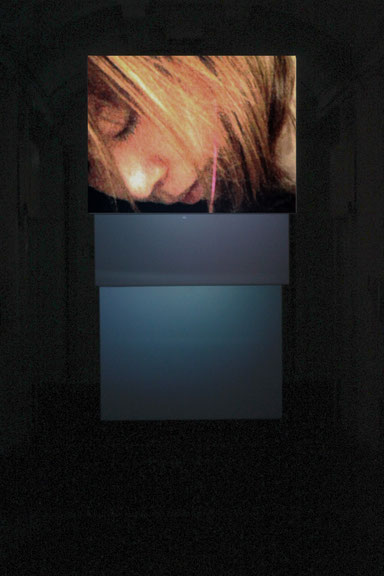Issue 2/2013 - Net section
Cinema in a Crematorium?
On the Forum Expanded exhibition Waves vs. Particles at this year’s Berlinale
Cinema as a space of projection and presentation has been greatly affected by a rapid succession of waves of new developments since digitization. It is not simply that digital technologies have democratized production; films are also disseminated at a much greater pace and circulate much more widely. Transfer rates and file sizes for sharing films via peer-to-peer networks re have also increased dramatically. New low-budget film formats are emerging online in computer game environments. Cinema’s greatest competitor is now held to be the Internet, or rather digital technologies and networks.
A project such as Aram Bartholl’s Vertical Cinema1 light-heartedly positions itself somewhere between art-film historical reference - Joan Jonas’ Vertical Roll - and a critique of the conventional, single-frame interface of YouTube, which offers a template that provides no scope at all for experimenting with formats. In the history of film art, “Expanded Cinema” began with the advent of portable projectors. Using a mini-video projector, Tony Oursler “burst open” video art’s pre-determined visual frame. In this respect, the installations at this year’s Forum Expanded exhibition at the Berlinale did not present any new approaches, but at most paid tribute to a long-standing discourse.
“Cinema is not dying; it is just changing to a huge degree, and stepping out of the movie theatre - so that there is a need to develop a different concept of cinema rather than talking about the death of cinema”, explains Stefanie Schulte Strathaus, Director of Forum Expanded in an interview on the Berlinale website. Yet which new cinematic concept does the Berlinale exhibition Waves vs. Particles actually propose?
Within the cold walls of the former crematorium where the exhibition is shown, the prevailing atmosphere is precisely what you would expect from a place dedicated to administering the dead. However, this is to a large extent the curators underscore the venue’s historical function, and build on this aura, making it inevitable that the ghost train of Expanded Cinema will emerge.
The colourful projections in Lucien Castaing Taylor and Véréna Paravel’s Spirits Still, made up of images taken from a documentary about deep-sea fishing, create an effect akin to light shining through stained-glass windows in the long corridor, which is lined to the ceiling with niches for urns. These projections, like all the others, cannot but submit to the place where they are shown. The kitsch climax is The Last Judgement by the same artist-duo, an excerpt from the documentary mentioned above; slow-motion footage of a flock of seagulls is projected onto the vaulted ceiling of the large, dimly lit funeral hall. The idea is that visitors will relax on big white cushions in this space to take in the view of the white birds cascading overhead. The crematorium’s new owner is the company Culture Park Wedding; its managing director, filmmaker Jörg Heitmann, is also the chairman of the supervisory board of the Arsenal Kino, the cinema that organises and screens the Berlinale’s Forum section. In the run-up to “creative” offices moving into the building, the company will be investing over one million euros in the building by 2014 – a not especially unusual re-development scenario in Berlin nowadays. A documentary film by Heitmann about, of all things, killing and being killed in a virtual game, is posted on the Internet.
Perhaps the exhibition should have moved closer to cinema again and called for cinema to adopt a more complex projection technique, with flexible screens, and more than one projector. That might have facilitated reception, for example of the 80-minute film installation The Life of Particles by Angela Melitopoulos and Maurizio Lazzarato. This filmic work, shown in the crematorium from three suspended screens set at an angle to each other, deals with the effects of nuclear power in Japan in the past (Hiroshima) and today (Fukushima). Two austere wooden benches were provided for the audience. Even if Aram Bartholl’s Vertical Cinema is, in contrast, more of a gag, it nonetheless touches on an important point, emphasising the importance of the cinema as a real place rather than focusing on screens on electronic devices. An experimental approach therefore emerges in a realm that could be most accurately described as “Expanded Video”. This is where experimentation with new forms of seeing is unfolding.
Waves vs. Particles, silent green kulturquartier (former crematorium, Wedding), Berlin, 7th–17th February 2013.
Translated by Helen Ferguson
